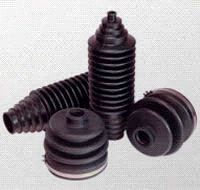Inkjet & Digital Printing
Picking Up Speed

Tuesday 25. March 2014 - Jaguar Land Rover finds competitive advantage with multi-material 3D printer
Jaguar Land Rover (JLR) installed an Objet500 Connex 3D Printer in the summer of 2008 because of its multi-material capability, which combines two different materials and draws on their best attributes to deliver superior models. In a company where product development is key, this was important.
The two global premium brands of Jaguar and Land Rover have been under single ownership since 2000, first as part of the Ford Motor Company and later as the UK based wing of the Indian TATA Group.
The two brands began with different perspectives. The Jaguar SS100 was launched in 1935 as the first 100 mph affordable sports car. With classic lines and high performance, it became the inspiration for a remarkable lineage of Jaguar cars with a reputation for speed, comfort and race winning.
In contrast, the first Series 1 Land Rover 80, built in 1948, was an all-purpose vehicle with a rugged, no-frills design and off-road capabilities. Today, there are eight vehicle lines produced by JLR. To ensure that these lines maintain their premium position in the marketplace, almost 20 percent of JLR’s workforce is employed on product development, proving designs with the latest CAD techniques, in-house prototyping and tooling quickly. In addition to CNC modeling and a fully equipped metalwork and toolshop, the prototyping capabilities include several rapid prototyping machines using SLA, laser sintering and polymer jetting technologies.
Prototyping Parts Direct from CAD Data
Jaguar Land Rover invested in the Objet500 Connex to broaden its resin-based rapid prototyping capabilities. The ability to create models directly from CAD data with elastomer, rubber-like materials and produce working mechanisms, were other key benefits that would contribute towards reducing development cycles. To prove its capability, the Connex was initially tasked with producing a complete facia air vent assembly for a Range Rover Sport. It used rigid materials for the housing and air-deflection blades, and rubber-like materials for the control knobs and air seal.
Jaguar Land Rover printed the complete facia air vent, as a working part, in a single process. Once printed, the model was taken from the printer, cleaned and tested immediately, proving that the hinges on the blades all worked, and the control knob had the right look and feel.
The backbone of the Objet Connex500TM is PolyJetTM technology. By jetting two distinctive model materials in preset combinations in a matrix structure, the printer creates multiple flexible and rigid materials with different mechanical and physical properties and finishes. Using this technology, Jaguar Land Rover’s Objet500 Connex has accumulated 5,000 hours of operation, printed more than 2,500 parts and used 600kg of resin. It’s a testament to the productivity and reliability of PolyJet technology that the 3D printer has required little maintenance and replacement of just five print heads throughout this time, at the intervals recommended by Objet to maintain optimum quality.
The number of parts produced on the printer has steadily increased as the team has found new ways to capitalize on the Connex capabilities. The figures are still only a small percentage of the 30,000 parts prototyped by Jaguar Land Rover every year, but many of these are laser sintered. For resin-based parts, the trend is in favor of the Objet500 Connex, which now accounts for more than one third of production.
Interestingly, the Objet 3D Printer is often used to produce single-material rigid parts due to its speed and simple post processing. When in multi-material, it is used for a variety of activities, including styling and human/machine interface concepts, such as knobs, switches and key fobs.
Fit and Function Testing
Over-molding is another important function of the Objet500 Connex. Two materials are used, but not mixed, to create, for example, a cover with rubber seal. Once cleaned, the assembly can be used directly for fit and function testing. Other key areas for use include the development of door seals and protective gaiters, where just the rubber-like material is used, and more recently the creation of parts for functional testing.
The JLR styling department is the biggest user of PolyJet capabilities. More than half of everything produced on the 3D printer finds its way into the design studio to help finalize new design proposals. For example, the Objet 3D printer was robust enough for rigorous testing of a telescopic headlight washing system that cleans headlights every fifth time the windshield is washed. Thus, the design was proven before JLR moved into an expensive tooling stage.
JLR engineers appreciated good part definition with high accuracy and dimensional control, as well as fast turnaround due to easy operation, a fast build speed and simple clean-up process. The Objet has impressed workers with its ability to prototype parts directly from CAD data that would have been time consuming or expensive by other means.
